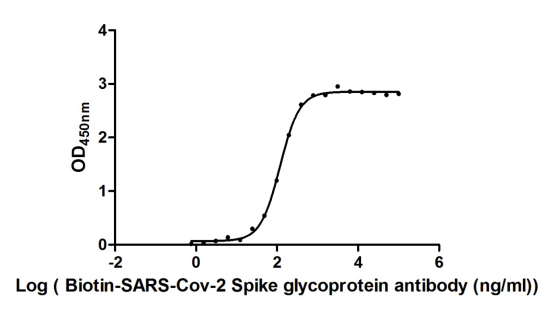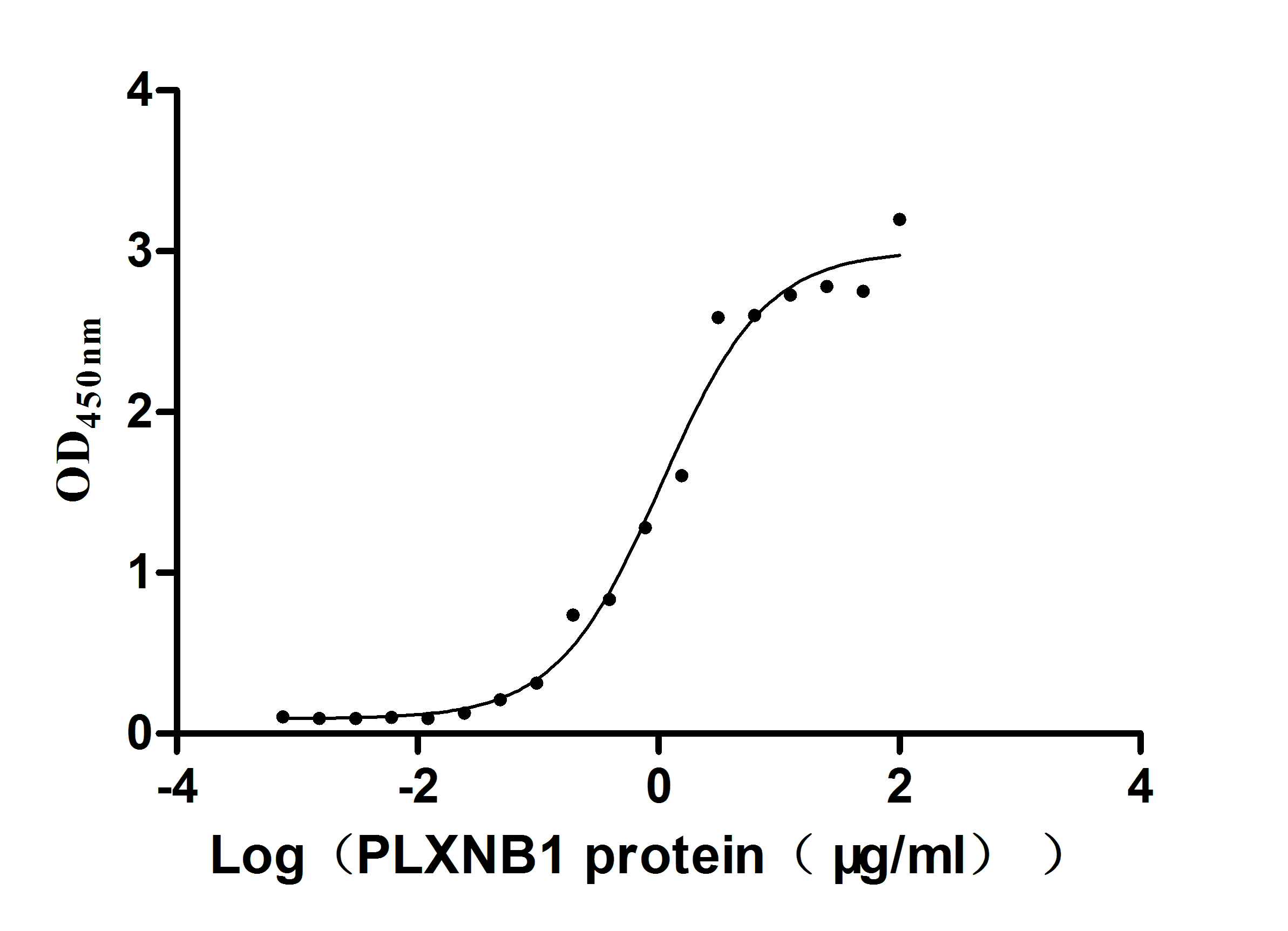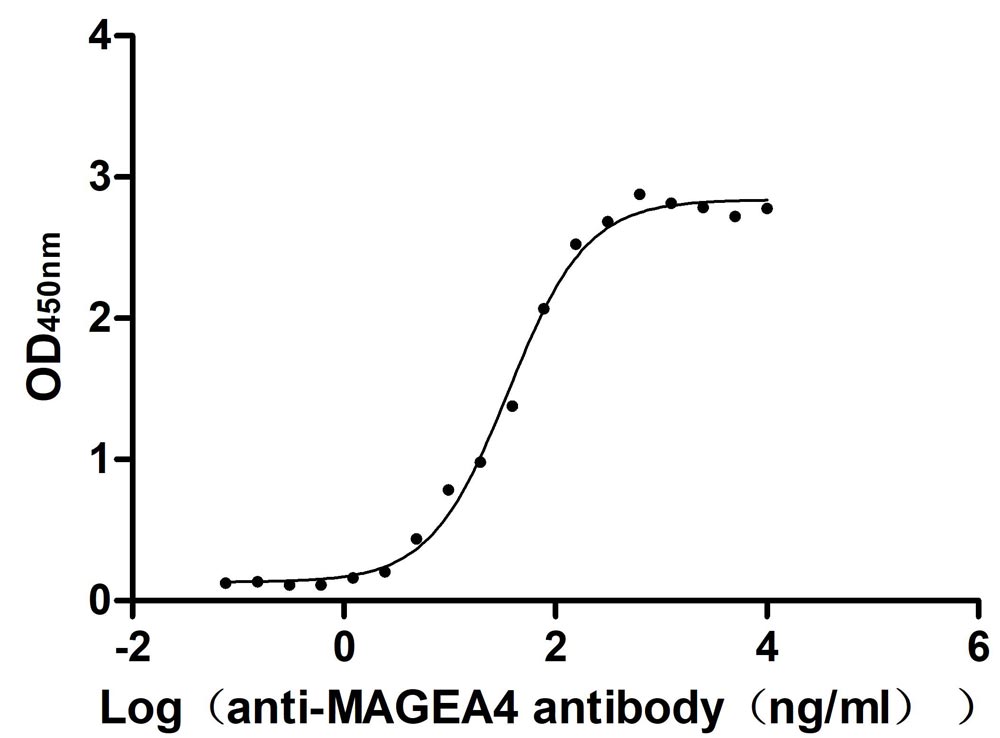Recombinant Rat Peroxisome proliferator-activated receptor alpha (Ppara)
-
货号:CSB-YP018421RA
-
规格:
-
来源:Yeast
-
其他:
-
货号:CSB-EP018421RA
-
规格:
-
来源:E.coli
-
其他:
-
货号:CSB-EP018421RA-B
-
规格:
-
来源:E.coli
-
共轭:Avi-tag Biotinylated
E. coli biotin ligase (BirA) is highly specific in covalently attaching biotin to the 15 amino acid AviTag peptide. This recombinant protein was biotinylated in vivo by AviTag-BirA technology, which method is BriA catalyzes amide linkage between the biotin and the specific lysine of the AviTag.
-
其他:
-
货号:CSB-BP018421RA
-
规格:
-
来源:Baculovirus
-
其他:
-
货号:CSB-MP018421RA
-
规格:
-
来源:Mammalian cell
-
其他:
产品详情
-
纯度:>85% (SDS-PAGE)
-
基因名:
-
Uniprot No.:
-
别名:Ppara; Nr1c1; Ppar; Peroxisome proliferator-activated receptor alpha; PPAR-alpha; Nuclear receptor subfamily 1 group C member 1
-
种属:Rattus norvegicus (Rat)
-
蛋白长度:Full length protein
-
表达区域:1-468
-
氨基酸序列MVDTESPICP LSPLEADDLE SPLSEEFLQE MGNIQEISQS LGEESSGSFS FADYQYLGSC PGSEGSVITD TLSPASSPSS VSCPAVPTST DESPGNALNI ECRICGDKAS GYHYGVHACE GCKGFFRRTI RLKLAYDKCD RSCKIQKKNR NKCQYCRFHK CLSVGMSHNA IRFGRMPRSE KAKLKAEILT CEHDLKDSET ADLKSLAKRI HEAYLKNFNM NKVKARVILA GKTSNNPPFV IHDMETLCMA EKTLVAKMVA NGVENKEAEV RFFHCCQCMS VETVTELTEF AKAIPGFANL DLNDQVTLLK YGVYEAIFTM LSSLMNKDGM LIAYGNGFIT REFLKNLRKP FCDIMEPKFD FAMKFNALEL DDSDISLFVA AIICCGDRPG LLNIGYIEKL QEGIVHVLKL HLQSNHPDDT FLFPKLLQKM VDLRQLVTEH AQLVQVIKKT ESDAALHPLL QEIYRDMY
-
蛋白标签:Tag type will be determined during the manufacturing process.
The tag type will be determined during production process. If you have specified tag type, please tell us and we will develop the specified tag preferentially. -
产品提供形式:Lyophilized powder
Note: We will preferentially ship the format that we have in stock, however, if you have any special requirement for the format, please remark your requirement when placing the order, we will prepare according to your demand. -
复溶:We recommend that this vial be briefly centrifuged prior to opening to bring the contents to the bottom. Please reconstitute protein in deionized sterile water to a concentration of 0.1-1.0 mg/mL.We recommend to add 5-50% of glycerol (final concentration) and aliquot for long-term storage at -20℃/-80℃. Our default final concentration of glycerol is 50%. Customers could use it as reference.
-
储存条件:Store at -20°C/-80°C upon receipt, aliquoting is necessary for mutiple use. Avoid repeated freeze-thaw cycles.
-
保质期:The shelf life is related to many factors, storage state, buffer ingredients, storage temperature and the stability of the protein itself.
Generally, the shelf life of liquid form is 6 months at -20°C/-80°C. The shelf life of lyophilized form is 12 months at -20°C/-80°C. -
货期:Delivery time may differ from different purchasing way or location, please kindly consult your local distributors for specific delivery time.Note: All of our proteins are default shipped with normal blue ice packs, if you request to ship with dry ice, please communicate with us in advance and extra fees will be charged.
-
注意事项:Repeated freezing and thawing is not recommended. Store working aliquots at 4°C for up to one week.
-
Datasheet :Please contact us to get it.
相关产品
靶点详情
-
功能:Ligand-activated transcription factor. Key regulator of lipid metabolism. Activated by the endogenous ligand 1-palmitoyl-2-oleoyl-sn-glycerol-3-phosphocholine (16:0/18:1-GPC). Activated by oleylethanolamide, a naturally occurring lipid that regulates satiety. Receptor for peroxisome proliferators such as hypolipidemic drugs and fatty acids. Regulates the peroxisomal beta-oxidation pathway of fatty acids. Functions as transcription activator for the ACOX1 and P450 genes. Transactivation activity requires heterodimerization with RXRA and is antagonized by NR2C2. May be required for the propagation of clock information to metabolic pathways regulated by PER2.
-
基因功能参考文献:
- MicroRNA-21 regulates peroxisome proliferator-activated receptor alpha expression in cardiorenal syndrome type 4, to alter cardiac pathology. PMID: 28760335
- The results suggested that PPARalpha activation may exert a protective effect against ischemia/reperfusion in the myocardium, at least in part via endoplasmic reticulum stress inhibition. PMID: 29568903
- Repeated activation of PPARalpha induced a decreased phosphorylation of beta2*nAChRs that was accompanied by a switch in firing pattern of spontaneously active dopamine cells. PPARalpha activation enhanced dopamine D1 receptor signaling in the nucleus accumbens shell (NAcS). Long-term PPARalpha stimulation restored dopamine signaling to sucrose consumption in the NAcS and appetitive motivation. PMID: 27457507
- findings unravel the mechanism of Arjunolic acid action in regressing hypertrophy-associated cardiac fibrosis by assigning a role of Arjunolic acid as a PPARalpha agonist that inactivates non-canonical TGF-beta signaling. PMID: 28821620
- Roux-en-Y gastric bypass upregulates striatal dopamine 1 receptor (D1R) expression specifically under high-fat diet feeding conditions. PMID: 28065827
- Metabolism of methiocarb and carbaryl alters PPAR alpha agonist activity. PMID: 27665777
- Ultraviolet absorber, 2-(2'-hydroxy-3',5'-di-tert-butylphenyl)benzotriazole exerts its hepatotoxicity through the PPARalpha signal pathway and the sex-related difference in PPARalpha expression may contribute to the sex-related difference in susceptibility to hepatotoxicity. PMID: 27665778
- Suggest the therapeutic effects of berberine on angiotensin IV-induced proliferation in cultured vascular smooth muscle cells are partially partially mediated by the PPARalpha-NO signalling pathway. PMID: 27927051
- PPARalpha-stimulation prevents overexpression of pro-inflammatory molecules in a model of acute myocardial infarction. PMID: 27050838
- UA inhibited the exaggerated spinal cord inflammatory response to peripheral inflammatory stimulation in HFDinduced obesity by restoring downregulated spinal PPARalpha, preventing peripheral inflammation and inflammatory hyperalgesia. PMID: 27108888
- PPAR-alpha-FGF21 induction by docosahexaenoic acid (DHA) and thyroid hormone (T3) may involve ligand activation of PPAR-alpha by DHA and enhanced expression of PPAR-alpha by T3. PMID: 27248050
- the results confirm the relation between the development of insulin-resistance with the over-expression of SREBP-1c, the reduction of PPAR-alpha expression and the predominance of large and triglyceride over-enriched VLDL circulating particles. PMID: 25796423
- GW0742 has the ability to improve glucose homeostasis in diabetic rats through activation of PPAR-delta. PMID: 26508837
- Stimulation of PPAR-alpha by medium chain triglycerides promotes reverse cardiac remodeling in chronic pressure overload. PMID: 25976666
- Age-related sensitivity to endotoxin-induced liver inflammation is mediated by IL-1beta-induced lipid accumulation in hepatocytes through the dysregulation of PPARa and SREBP1c. PMID: 25847140
- Fructose feeding significantly decreased mRNA levels for PPAR alpha and CPT1A. PMID: 26519879
- Data suggest that expression of PPARA in liver can be regulated by dietary factors; here, dietary supplementation with 5-caffeoylquinic acid up-regulates expression of PPARA and prevents high-fat diet induced obesity. PMID: 25186103
- Stimulation of PPARalpha by clofibrate prevents an increase in the activity of renin-angiotensin system and promotes the production of vasodilator substances in myocardial ischemia. PMID: 25658458
- Tau supplementation prevented obesity and hepatic TG deposition by upregulating MTP mRNA, ameliorating hepatic lipid efflux, and consequently enhancing PPAR-alpha which increases lipid oxidation through ACO and CPT-1a gene expressions. PMID: 26092479
- Findings suggest that diet-induced obesity causes down-regulation of spinal PPARalpha, which facilitates the susceptibility to peripheral inflammatory challenge by increasing inflammatory response in the spinal cord. PMID: 25135355
- results demonstrate that inhibition of PPARalpha attenuates the beneficial effects of metformin on mitochondria in acute IR. PMID: 22837722
- In cardiomyocytes the protective effects of metformin-induced AMPK activation against oxidative stress converge on mitochondria and are mediated, at least in part, through the dissociation of PPARalpha-CypD interactions. PMID: 25617357
- the phosphorylation of ERK1/2 inhibited the expression and activity of SCAD through the PPARalpha signaling pathway, which induced the development of pathological cardiomyocyte hypertrophy. PMID: 25636810
- PPARalpha contributes to regulation of blood pressure and vascular reactivity in SHR, and clofibrate-mediated reduction in blood pressure and proteinuria is probably through increased NO production. PMID: 24562305
- data uncover HILPDA as a novel PPAR target that raises hepatic triglyceride storage via regulation of triglyceride secretion. PMID: 24876382
- Peroxisomal multifunctional enzyme type 1 (rpMFE-1) undergoes Posttranslational Modification on several N epsilon-Lys residues under PPAR-alpha-mediated peroxisome proliferation. [peroxisomal multifunctional enzyme type 1] PMID: 24092543
- Systemic disorganization of functional activity of nuclear PPAR plays a key role in the molecular mechanisms of metabolic and immune disturbances in rats with inherited stress-induced arterial hypertension. PMID: 24288751
- These findings unveil novel roles for PPARalpha in mediating stress signals between hepatic subcellular stress-responding machinery PMID: 24735884
- After spinal cord injury, there is a long-lasting in the level of PPARalpha in white matter in the vicinity of the lesion site. PMID: 23958344
- Urotensin-II can protect renal tubular cells from apoptosis through PGI2-mediated PPARA and Akt activation. PMID: 23933501
- A decrease in the expression of Nrf2 and PPARalpha, together with an increase in NF-kappaB expression, was observed in the renal cortex of L-NAME-induced hypertensive rats compared with control rats. PMID: 23223967
- PPAR signaling pathway is activated following ethyl tertiary-butyl ether administration which leads to tumorigenesis. PMID: 24090815
- glomerular hypertrophic responses in rats on a HFD are associated with reduced PPARdelta expression and increased p38 MAPK phosphorylation. PMID: 23592661
- Growing evidence points to PPARalpha as an additional detector of metabolic signals and altered functional demands, able to set into motion prompt responses to cope with ongoing metabolic needs and maintain cell homeostasis. PMID: 23394525
- in ischemia-reperfusion, functional interplay between the decrease in L-carnitine and the PPARalpha/PGC1alpha pathway-induced redirection of fatty acid metabolism protects mitochondria against long chain fatty acid overload PMID: 23525500
- novel differences in the regulation of lipins 1,2,3, PPARalpha, and PGC-1alpha splice variants during fasting in heart versus liver, even though the ultimate outcome in both tissues is to increase FA turnover and oxidation. PMID: 23505321
- The hypocholesterolemic functions of chlorogenic acid are probably due to the increase in fatty acids unitization in liver via the up-regulation of peroxisome proliferation-activated receptor alpha mRNA. PMID: 22674675
- Activation of PPAR-alpha played a protective role in acute pancreatitis, partially mediated by modulation of TLR pathways. PMID: 22722259
- PPARalpha plays a role in the regulation of the ubiquitin proteasome system. PMID: 23041501
- PPARalpha significantly contributes to the effects of endogenous cholinergic transmission mediated by ss2-nicotinic acetylcholine receptors on dopamine (DA) neuron excitability and to the effects of nicotine on locomotor activity, a DA associated behavior. PMID: 20570248
- PPARalpha activation improves endothelial dysfunction and reduces fibrosis and portal pressure in cirrhotic rats. PMID: 22245887
- Pharmacological activation of PPARalpha improves metabolic milieu, steatosis, ballooning, and combats NF-kappaB and JNK activation, neutrophil and F4/80 macrophage recruitment in diabetes-related NASH. PMID: 21929649
- Peroxisome proliferator-activated receptor-gamma regulates inflammation and renin-angiotensin system activity in the hypothalamic paraventricular nucleus and ameliorates peripheral manifestations of heart failure. PMID: 22083161
- PPARalpha can compete with GATA-4 binding to NFATc4 PMID: 22198280
- Abnormal expressions of FXR and PPARa may play a role in pathogenesis of estrogen-induced intrahepatic cholestasis. PMID: 21205480
- findings suggest that increased PPAR-alpha expression in OLETF rats liver is a contributory factor to the exercise-related improvements in whole-body metabolism. PMID: 21618160
- Integrated investigation of PPAR, LXR, PXR, CAR regulatory mechanisms, signal transduction and transcriptional targets will provide insights into the pathogenesis of MS and offer valuable information for designing of drugs for MS treatment. PMID: 22066269
- Evidence indicating the involvement of the saturated acylethanolamide palmitoylethanolamide in allopregnanolone synthesis through PPAR-alpha in astrocytes. PMID: 21554431
- Activation of PPARalpha protects cells in dentate gyrus and hippocampus from excitotoxic insult. PMID: 20221904
- Upregulation of apoA5 expression contributes to the triglyceridelowering effect of statins via the PPARalpha signaling pathway. PMID: 21092650
显示更多
收起更多
-
亚细胞定位:Nucleus.
-
蛋白家族:Nuclear hormone receptor family, NR1 subfamily
-
组织特异性:Expressed predominantly in liver and kidney.
-
数据库链接:
KEGG: rno:25747
STRING: 10116.ENSRNOP00000038651
UniGene: Rn.9753
Most popular with customers
-
Recombinant Severe acute respiratory syndrome coronavirus 2 Spike glycoprotein (S), partial (Active)
Express system: Mammalian cell
Species: Severe acute respiratory syndrome coronavirus 2 (2019-nCoV) (SARS-CoV-2)
-
Recombinant Human Tumor necrosis factor ligand superfamily member 9 (TNFSF9), partial (Active)
Express system: Mammalian cell
Species: Homo sapiens (Human)
-
Recombinant Human Plexin-B1 (PLXNB1), partial (Active)
Express system: Mammalian cell
Species: Homo sapiens (Human)
-
Recombinant Human IGF-like family receptor 1 (IGFLR1), partial (Active)
Express system: Mammalian cell
Species: Homo sapiens (Human)
-
Recombinant Human Signal transducer CD24 (CD24)-Nanoparticle (Active)
Express system: Mammalian cell
Species: Homo sapiens (Human)
-
Recombinant Human Claudin-18.2 (CLDN18.2)-VLPs (Active)
Express system: Mammalian cell
Species: Homo sapiens (Human)
-
Recombinant Human Melanoma-associated antigen 4 (MAGEA4) (Active)
Express system: Mammalian cell
Species: Homo sapiens (Human)
-
Recombinant Macaca fascicularis CD44 antigen (CD44), partial (Active)
Express system: Mammalian cell
Species: Macaca fascicularis (Crab-eating macaque) (Cynomolgus monkey)







-AC1.jpg)












